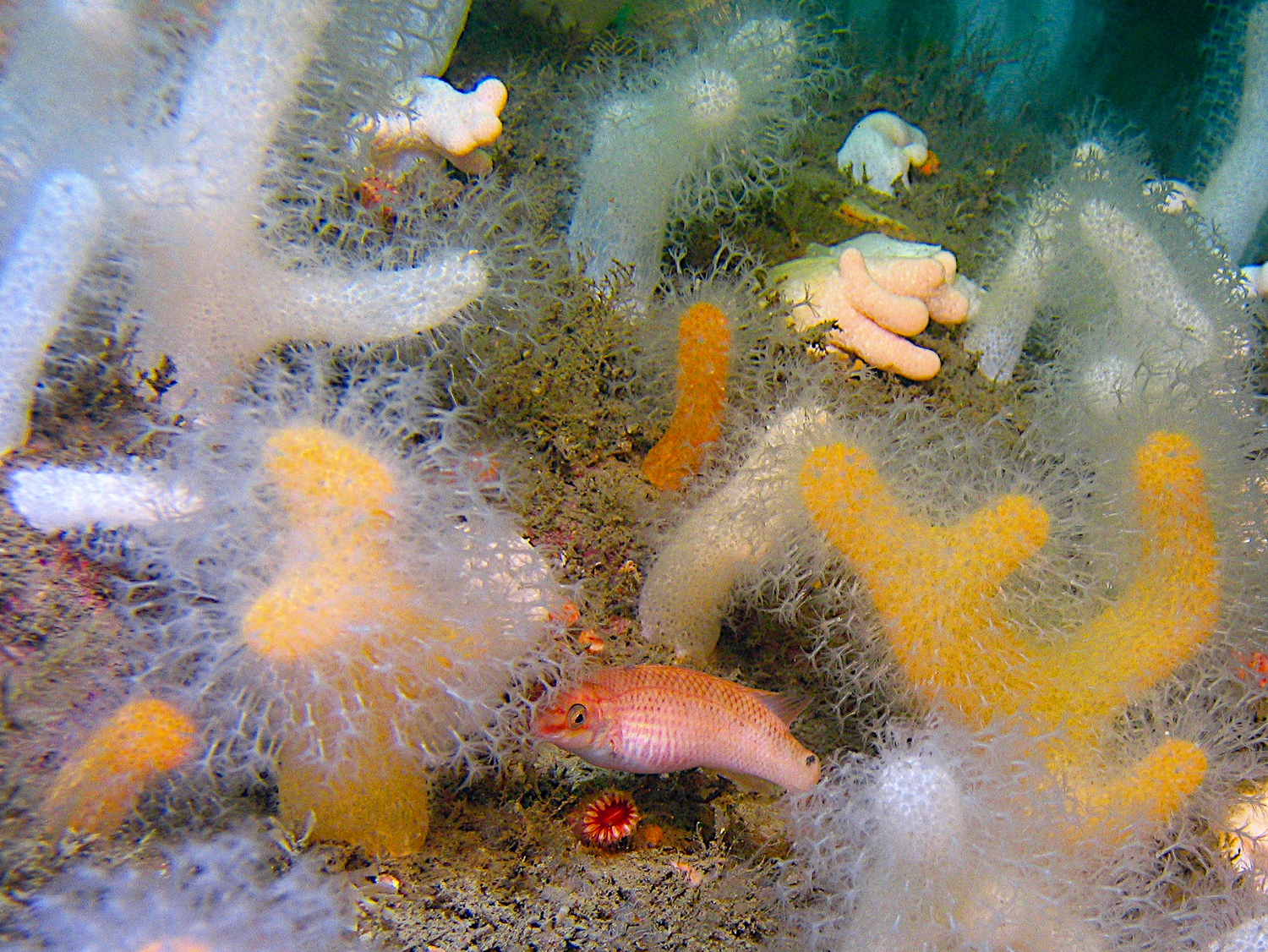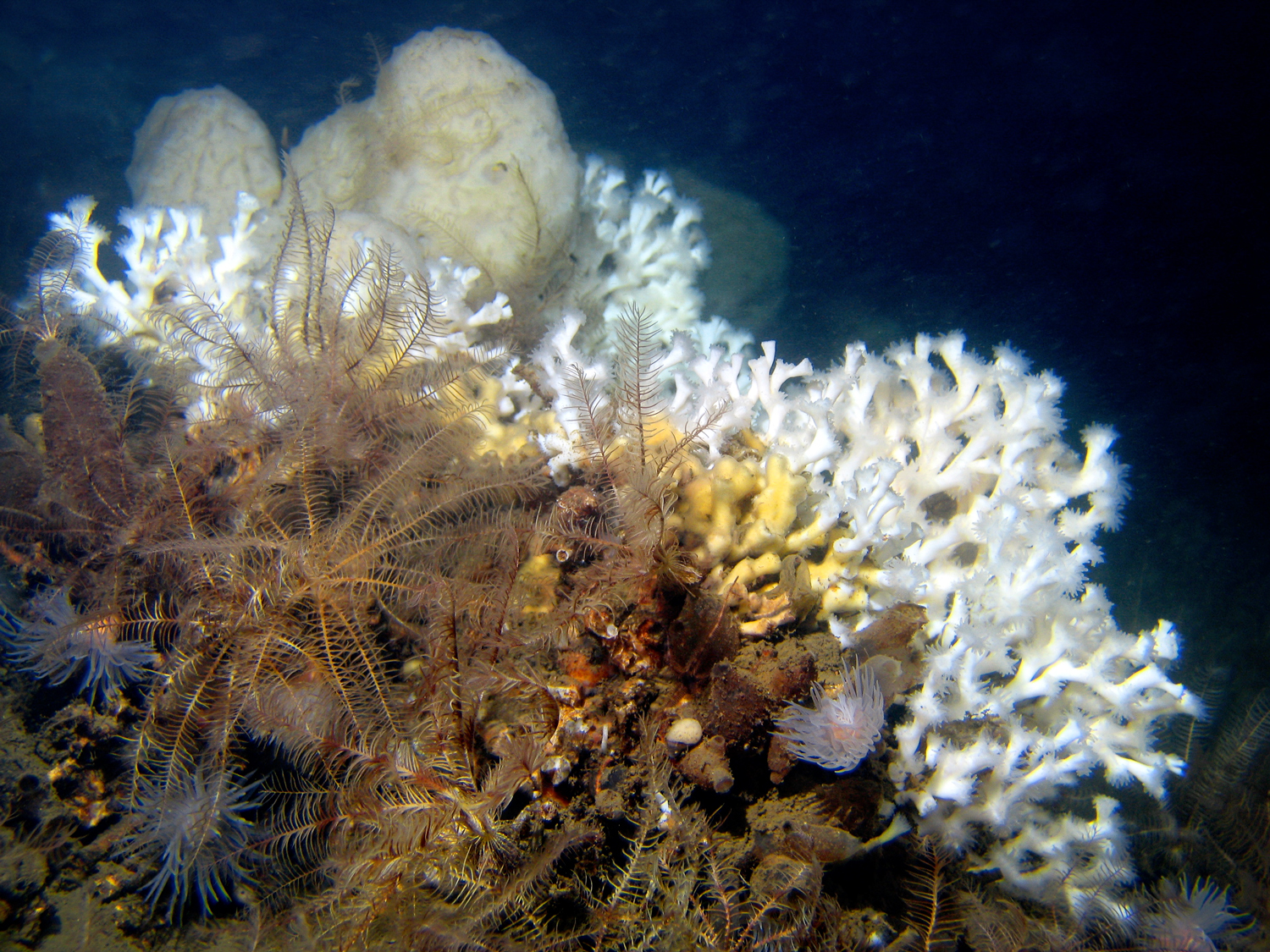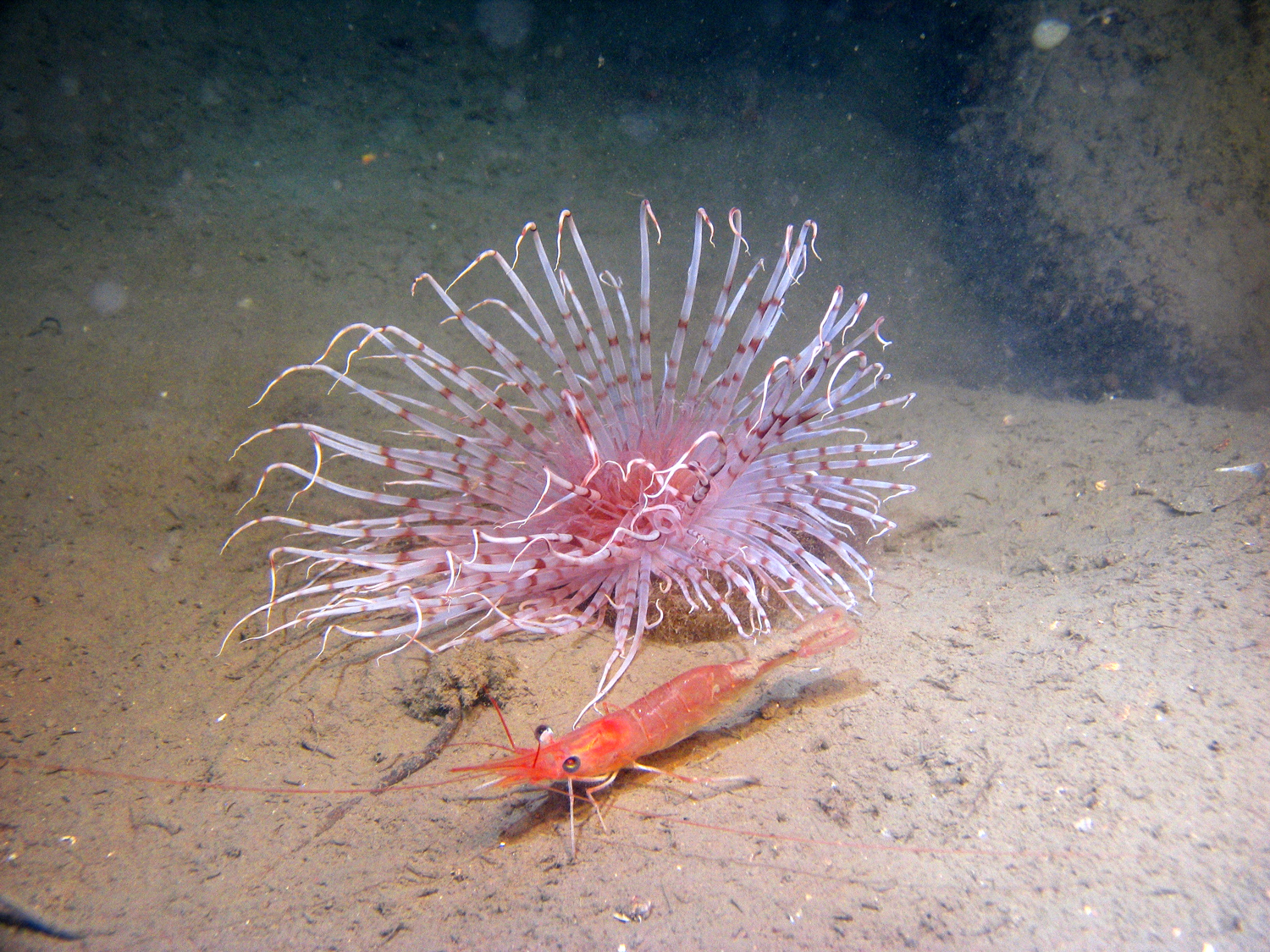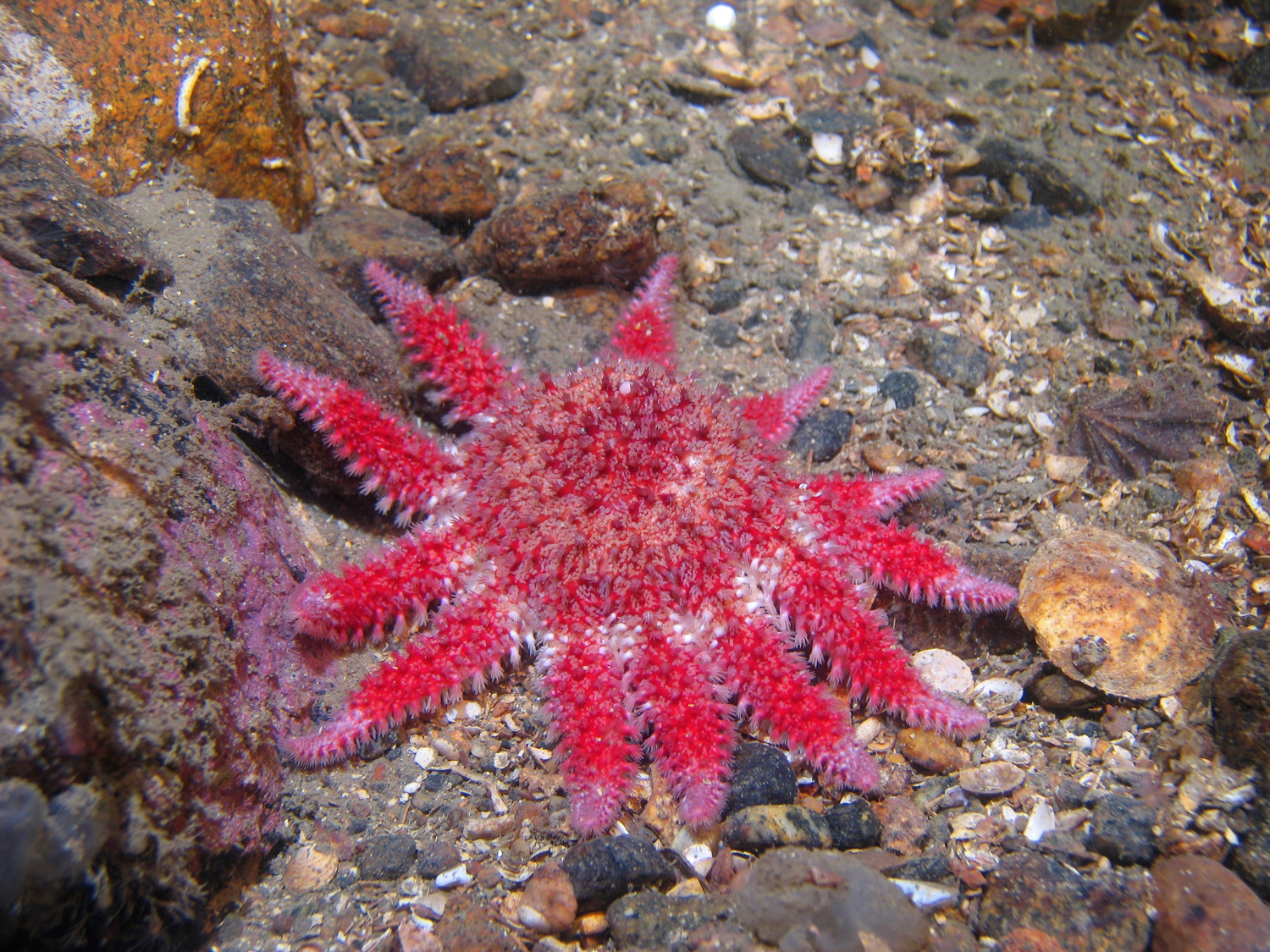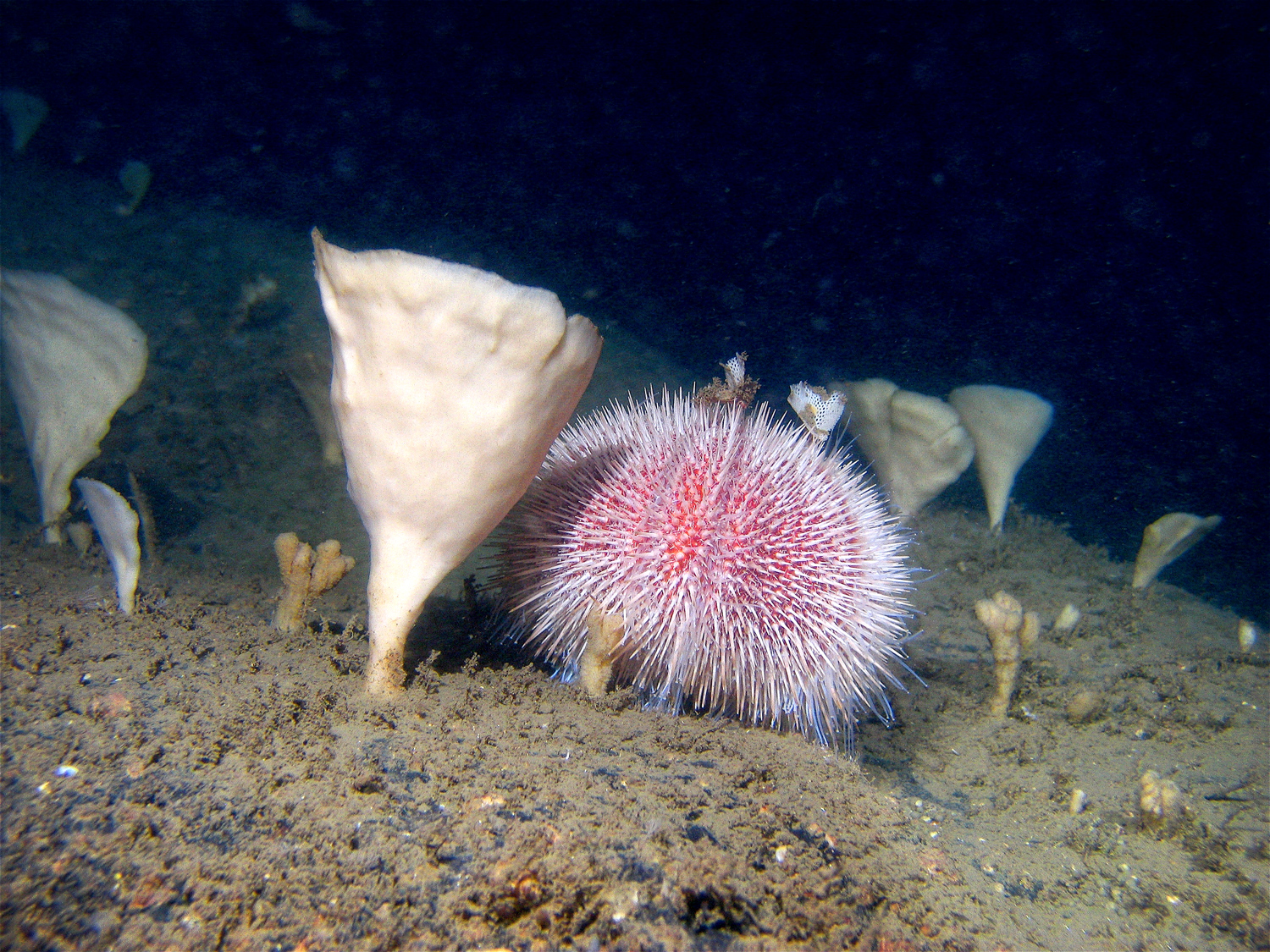Cold-water coral research
By Susanna Strömberg
In the NE Skagerrak there is a system of troughs channeling deep oceanic water with Atlantic origin into areas that normally wouldn't be characterized as deep sea (i.e. the Fjord effect). Due to this you can find cold-water corals and other deep sea benthic fauna as shallow as 80 m. The diversity of the deep benthos of the area is unique in Swedish coastal seas, and this has lead to the establishment of the first marine national park in Sweden. At the same time, Norway established a national park in the adjacent Hvaler area. Together the two national parks cover an area of 800 square kilometers. The University of Gothenburg established a marine biological field station in the area already in 1963 due to the Fjord effect and unique fauna.
Maps of the global distribution of Lophelia pertusa you can find at the NOAA's Coral Reef Information System (CoRIS) or in the UNEP-WCMC document "Cold-water coral reefs: out of sight - no longer out of mind" by André Freiwald et al. The latter is a very informative document describing several cold-water coral species and their distribution, biology, ecology, and threats.
North Sea and Skagerrak - the red rectangle marks out the study area in the northeast Skagerrak and northern Bohuslän. The Norwegian Trench brings deep Atlantic water into the area.
The Norwegian and Swedish archipelagos with the bathymetry of the deep Koster Trough visible and cold-water coral reefs marked out by red circles
The marine biological field station is marked out in the map as SLC (Sven Lovén Centre of Marine Sciences), previously known as Tjärnö Marine Biological Laboratory.
The red circles marks out live reefs in the area, and the yellow circles mark out sites where there has been live reefs. The last two decades only dead coral fragments have been found here. At the site marked with a red asterisk two small live colonies were found in summer 2010, and it's not known yet whether these are survivors from the old reef or new recruits.
The mapping of cold-water corals by means of ROV-technology in the area started in 1998 by Tomas Lundälv and Lisbeth Jonsson. Read more at the ROV project homepage.
Restoration Ecology
“Returning a system to a close approximation of its condition prior to distrubance, with both the structure and function of the system recreated.”
Restoration Ecology is a relatively new research field and most projects with a pre-defined scientific approach focused on ecological restoration has been in terrestrial environments. In marine environments the use of "artificial reefs" has earlier been addressing other issues than attempting to restore ecosystem function, e.g. fisheries enhancement or shore protection. The conservational aspect has emerged during the last decades but then with the persistent heritage of artificial reef construction for other purposes.
Many purely expermimental studies on settling of marine benthic organisms has resulted in a broad knowledge of different species preferences of a number of substrate qualities like; rugosity, orientation, cryptic or exposed, depressions or elevations etc. The lessons from these experiments has often been that the more complex the substrate is, the richer the settled fauna will be. Substrate heterogeneity gives a multitude of different nisches attracting a larger number of different species.
"Sekken" - The fjord and sea border between Norway and Sweden. Photo ©: Lars-Ove Loo
These lessons has rarely been adopted to the applied field of coral habitat restoration. Still, many restoration programmes are using simple pre-fabricated concrete units with smooth surfaces as previously used in projects aiming at shore protection or fish attraction. Few has attempted to mimic natural habitats, and so far the only projects to my knowledge that has used hydrodynamics as a factor in artificial reef design has been aiming at shore protection.
In this restoration project I will try to mimic the natural habitat, and work with hydrodynamics in the design of the artificial reefs. I'm hoping that this will increase settling success and shorten the time needed for the artificial reefs to reach a similar species diversity as a natural reef.
Habitat Restoration
Habitat restoration aiming at returning an ecosystem to a pre-impact state of structure and function requires that you know what this state was. Often in deeper marine environments you don't. The technology to get in situinformation about the deep-sea ecosystems is recently gained. Before that, the development of the bottom-trawling fisheries to heavier gear able to plow their way through the delicate reef habitats had already destroyed much of the habitats we now can go down and look at by means of unmanned (ROVs) or manned submersibles equipped with strong headlights and video cameras. We will often have to make a "best guess" of the pre-impact state of the system we want to restore.
An ecosystem is built by both abiotic and biotic derived structures, and in cold-water coral reefs the main structure is built by one stony coral species - Lophelia pertusa is the main ecosystem engineer of its habitat. There are other stony corals, but they play in another league than Lophelia. Replanting Lophelia is therefore the number one priority, however, it's a slow growing species and you need an abiotic foundation as a substitute for the dead matrix of coral skeleton that usually is present in a reef, i.e. an artificial reef.
What then is the function of a CWC reef? The coral skeleton matrix act as a hydrodynamic trap of nutritious particles and pelagic larvae, thus concentrating nutrients and settling of marine benthos within the reef. It also provide shelter and foraging grounds to animals higher up in the trophic food web. This is the ecosystem function you want to restore.
The key factors you need to identify are:
- the pre-impact state (from available data and/or a reference site)
- the proper restoration endpoint (guided by the above)
- the local restoration potential or constraints (limited larval pool?)
- the functional groups (in this case Lophelia is the key functional species, but there can be more less obvious ones)
- the key linkages (e.g. food web interactions, symbiotic relationships)
- the essential matters to be cycled within the system
- the natural or human induced disturbance regimes that the restored habitat will need to buffer against
- and, finally, what are the key factors that you need to include in the analysis to assess the success?
This 'restoration ecologist's checklist' is derived from a paper written by Palmer et. al (1997), an excellent paper linking Community Ecological Theory with Restoration Ecology and the possibility of cross-fertilization between the two fields. This paper is my map and compass throughout this PhD project. The examples are from ecological restoration in terrestrial habitats, but the authors have managed to generalize so well that you can apply the thinking in any environment. In fact, you could read it solely to understand the magic of generalization. That is a trick that could get your papers into the highest ranked international journals. After reading it the first time I couldn't really tell whether it had a marine or terrestrial focus. It was applicable to my work, so I assumed that it had some marine examples. Reading it again, however, I realized they're talking beetles and grassland. The closest they get to aquatic environments are examples from wetlands and river regulation. They were nowhere near coral reef restoration.
Reference
Palmer M.A., Ambrose R.F., Poff N.L. (1997) Ecological theory and community restoration ecology. Restoration Ecology 5:291-300pp
Welcome to the Guide to all Phyla and the Illustrated Species List
The organisms portrayed in the illustrated species list were sitting on six sets of ceramic tiles (48 in total) deployed at the cold-water coral reef at Saekken, NE Skagerrak. After 5-6 years of deployment at 85 meters depth, this is what was staring back at me when I looked at the tiles through the stereo magnifier. The organisms are grouped by the higher taxonomic ranking phylum (e.g. mollusks, cnidarians, 'moss animals' etc) and the lower rankings (i.e. class, order and family) are displayed as headlines above the images. There is also a complete species list with the higher taxonomic rankings displayed. In the species list you can also see if a specific species is depicted in the illustrated list. In the guide to all phyla you will get a short description of the groups, and the small image next to each phylum is a link to the illustrated species list with a photo gallery of some of the species within this group.
Cold-water corals and associates
UW-photo by Tomas Lundälv. The image was taken with a camera mounted on the ROV (Remote Operated Vehicle, an unmanned submersible)
The complex matrix of coral branches creates turbulence in the water, increasing the fall-out of nutritious particles and larvae within the reef. This is the key to why coral reef habitats are amongst the richest in species diversity and abundance. Most of the species found in coral habitats reflects the local fauna and can be found on other substrates. Of the local species pool four groups were found in much larger numbers close to corals; i.e. sponges (Porifera), crustaceans, bristleworms (Polychaeta, Annelida), and 'moss animals' (Bryozoa). But some organisms are extra tightly linked to the coral habitat and is found almost solely in this type of environment. The true 'coral lovers' are presented below.
Photo © Susanna M. Strömberg
The polychaete Eunice norvegica (below to the left) can become 25-30 cm long and builds parchment like tubes along the coral branches. The corals then calcify the tubes, making both the coral branches and the tube stronger. Despite the fierce looking fangs (see the image further down on the page) it is supposed to eat foraminiferans (unicellular protozoans). The odd looking hemichordate Rhabdopleura normani is another organism found solely in coral habitats (images to the right below). The larger image shows the colony with its blood red stolon and perpendicular transparent annulated tubes. In these tubes the individual animal resides, and one of them is seen out of its tube on the bottom right image.
The brachiopod Macandrevia cranium (bottom, middle) was a regular catch in samples taken in the Koster Fjord up until the 1970's. But with the decline of coral cover it dissapeared, and is now only found at Saekken. Below you also find a squat lobster (Munidopsis serricornis) that is common in the reefs. In tropical reefs they have found that corals benefit from symbiotic relationships with trapezoid crabs. The crabs act as housekeepers and clean the corals from particles too big for them to shed off, and the crabs benefit by getting a safe foraging area between branches. Studies shows that transplanted corals with crabs have better survival than corals without. Munidopsis could be the housekeepers of Lophelia reefs. This type of win-win relationship amongst animals is called mutualistic symbiosis.
Left: Eunice norvegica with extruded fangs. Middle: you often see the claws of the small squat lobster Munidopsis serricornissticking out between branches of corals. Right: Barentia sp. (Entoprocta) was found almost solely on panels close to corals.
The soft octocoral Alcyonium norvegicum is one of the invertebrates thriving in the stony coral habitat. It was only found on the panels that had been very close to corals. 202 colonies of A. norvegicum were found on the two racks closest to the Lopheliacolonies, while only two small ones were found on the four racks standing more than three meters away from the stony corals.
Settling panels
UW-photos by Tomas Lundälv.
UW-photos by Tomas Lundälv.
Settling panels standing several meters away from any living coral colonies where surprisingly "clean" despite the long residence time and occupied mainly by the feather star Hathrometra sarsii (Crinoidea, left image). Underneath the racks, on the protected sides, there were however a denser population of settled organisms. The feather stars are mobile species attaches only by 'cirri' (jointed feet) and can let go and swim off to settle down elsewhere when disturbed. They ususally occupy any protruding object on the seafloor in this area. Panels standing closer to live coral colonies (right) had much denser colonization and here the exposed sides had large colonies of the colonial serpulids Filograna implexaand Salmacina dysteri. They had settled on the wake side of the panels (according to dominating current direction) and grew over the top of the rack. The brown "fur" on the panels are arborescent foraminiferans, unicellular organisms with a bushy cover of sediment particles. There is also a long arched sediment tube of a peacock worm (Sabella pavonina) and some tunicates visible on the exposed surfaces. A small soft octocoral (Alcyonium norvegicum) and other organisms were also present but too small to be seen on the image. On the image to the right you can see colonies ofLophelia in the background to the right.
Species List --->
Welcome
Susanna Strömberg
I am a PhD student at the University of Gothenburg working with the cold-water coral Lophelia pertusa. Due to the decline in coral cover in the Koster Sea (NE Skagerrak), and lack of spontaneous recovery, there is a need for active restoration measures to re-establish L. pertusa in the area. The aim of my PhD studentship will be to test and develop artificial substrates that will form a solid foundation for replanted coral colonies and substitute for loss of habitat complexity until the corals have reached a size when they can provide the functions of a fully grown reef.
On these pages you will be able to follow the progress of the artificial reefs - the making, deployment, and development in situ at 80-90 meters depth.
Cold-water coral Habitat Restoration
While restoration of shallow tropical coral reefs have become a wide spread practice with many more or less successful examples over the years, the attempts of restoring deep CWC habitats is almost non-existing. Outside the coast of Florida at the Experimental Oculina Research Reserve restoration experiments testing the transplantation potential for Oculina varicosa started already in 1996. Oculina varicosa is a species similar toLophelia pertusa with the same type of growth pattern. So far this is the only restoration project in CWC habitats to my knowledge. There has been modest results, both in CWC and tropical restoration projects, and there is a need for further development of restoration methods.
Read more under habitat restoration.
This PhD is financed by The Swedish Research Council Formas and the University of Gothenburg.
Bottom-trawling video
"Every year an area twice the size of the contiguous USA is being trawled"
In many areas the deep coral habitats has been severely reduced. In Norway it is estimated that 30-50% of the reefs have been damaged or destroyed. In Australia and New Zealand as much as 90% of the reefs have been destroyed due to the orange roughy fisheries.
There are many scientific references of trawling impacts, here are two examples:
Fosså J.H., Mortensen P.B., Furevik D.M. (2002) The deep-water coral Lophelia pertusa in Norwegian waters: distribution and fishery impacts. Hydrobiologia 471:12
Koslow J.A., Gowlett-Holmes K., Lowry J.K., O'Hara T., Poore G.C.B., Williams A. (2001) Seamount benthic macrofauna off southern Tasmania: community structure and impacts of trawling. Marine Ecology Progress Series 213:111-125
Most of my university studies I accomplished at the Universtiy of Stockholm, however, I moved across Sweden and did my Master project at the University of Gothenburg and the Dept. of Marine Ecology's field station at Tjärnö. I finished my Master during the spring semester in 2007, supplemented with some statistics, and got my final Degree of Master of Science with a Major in Biology 2009.
Mean while, during 2007-2009 I was working as a project assistant. First I continued working with the same project I did my Master within - looking at settling panels that had been deployed at the Saekken reef, comparing species composition and abundances on panels at different distances to live coral colonies. The project was initiated by Tomas Lundälv and Lisbeth Jonsson at the Tjärnö lab.
Ideas was beginning to emerge and I managed to get funding from the Swedish Environmental Protection Agency to test the method of mineral accretion (Hilbertz and Goreau, 1996) and the possibility to use this in cold-water coral habitat restoration. The experiments resulted in a paper (see publications below). Ideas continued to emerge and I ended up with ideas for a full PhD, but no funding. It took three years and ten applications, but finally, with the help of three prominent professors at the Tjärnö lab (Kerstin Johannesson, Per Jonsson, and Henrik Pavia), funding was granted and I could get myself into some serious deep shit...
Susanna Strömberg (PhD student) University of Gothenburg
susanna.stromberg @gu.se
Department of Marine Ecology, Tjärnö SE-452 96 Strömstad, Sweden
I commenced my position as a PhD student in March 2011.
CV and Degree Certificate
publication(s)
Strömberg S.M., Goreau T.J., Lundälv T. (2010) Suitability of mineral accretion as a rehabilitation method for cold-water coral reefs. J Exp Mar Biol Ecol 395:153–161
Abstract

